Articles
All articles | Recent articles
Introduction of Glassy Spheres in an Acrylic Matrix: A New Solution for Low-Pressure Sanitaryware Moulds
A. Fortuna1, D. M. Fortuna1, E. Martini1, V. Tagliaferri2, G. Rubino3
1 SE.TE.C. Srl, via Enrico Fermi 6/18, 01033 Civita Castellana (VT), Italy
2 Department of Business Engineering, University of Rome "Tor Vergata", Via del Politecnico 1, 00133 Rome, Italy
3 Department of Economics and Business, University of Tuscia, Largo dell'Università, 01100 Viterbo, Italy
received May 6, 2015, received in revised form July 1, 2015, accepted July 17, 2015
Vol. 6, No. 3, Pages 249-254 DOI: 10.4416/JCST2015-00019
Abstract
In this work we have conducted a study to improve the mechanical strength and abrasive wear of the moulds used for traditional casting in the sanitaryware industry. We replaced the beta gypsum commonly employed in low-pressure moulds with a mix of alpha plaster and acrylic resin (Poolkemie Ecoresin). This product greatly improves the mechanical properties of the mould, but does not enable adequate thickness formation owing to the low porosity of the compound. For this reason we introduced increasing amounts of Poraver glassy spheres (10 %, 20 %, 30 %, 40 %) with the goal of ensuring the same thickness formation as in the case of the beta plaster, but with higher values for flexural strength and abrasion resistance. We conducted a series of abrasion tests and obtained good values with all samples containing spheres. In the mechanical flexural test, the best result was obtained by the resin formulation, but we also obtained very good results for 10-% and 20-% samples. On the other hand, in the casting test the best thickness is obtained with the formulation using 20 % spheres. This mix is therefore the best compared to the beta plaster and can definitely be applied in low-pressure casting.
![]() Download Full Article (PDF)
Download Full Article (PDF)
Keywords
Keywords: Sanitaryware casting, thickness formation, beta plaster moulds, acrylic resin and glassy spheres, flexural strength and abrasion resistance.
References
1 Fortuna, D.: Sanitaryware, Faenza editrice, Faenza, Italy, 2000.
2 Fortuna, D.: Sanitaryware casting, SE.TE.C. srl editorial, Civita Castellana, 2011.
3 Fortuna, D.: Difetti degli smalti dei sanitari in ceramica, Faenza editrice, Faenza, Italy, 2006.
4 Aliprandi, G.: Principi di ceramurgia e tecnologia ceramica, 2nd edition, E.C.I.G., Genua, 1975.
5 Peco, G.: I prodotti ceramici: Dalla tradizione all'alta tecnologia, Marzorati editore, Milan, 1991.
6 Kingery, W.D., Bowen, H.K., Uhlmann, D.R.: Introduction to Ceramics, 1st edition, J. Wiley & Sons, New York, 1975.
7 Lucas, G.: Capillary conductivity and body formation in moulds of special plaster: results from laboratory and practice, Interceram, 46, [6], 419 – 424, (1997).
8 Lucas, G.: Capillary conductivity and body formation in moulds of special plaster: results from laboratory and practice (Part II), Interceram, 47, [1], 7 – 11, (1998).
9 Mariani, E.: Chimica applicata ed industriale, Ed. UTET, Torino, 1974.
10 Jouenne, C.A.: Traité de céramiques et matériaux minéraux, Ed. Septima, Paris, 2001.
11 Boenigk, P. : Utilisation des moules en platre pour la production des tuiles terre cuite, Verre Presse Services, Paris, 1993.
12 Adcock, D.S., Mcdowall, I.C.: The mechanism of filter pressing and slip casting, J.A.C.S., 40, [10], 335 – 362, (1957).
13 Hogg, S.C.: Confronto tra la colatura dei sanitari sotto pressione e colatura tradizionale in stampi, con particolare riferimento alle proprietà delle argille, Ceramurgia, 16, [2], 69 – 74, (1986).
14 Gainer, T.M., Carter, J.A.: Pressure casting sanitaryware, Ceram. Bull., 43, [11], 11 – 19, (1964).
15 Viola, E.: Esercitazioni di scienza delle costruzioni, Volume 2, Pitagora Editrice, Bologna, 1985.
16 Gadelmawla, E.S., Koura, M.M., Maksoud, T.M.A., Elewa, I.M., Soliman, H.H.: Roughness parameters, J. Mater. Process. Tech., 123, [1], 133 – 145, [13], (2002).
17 ISO 4287:1997 Geometrical Product Specifications (GPS), Surface texture: Profile method, terms, definitions and surface texture parameters, International Organization for Standardization, ISO Central Secretariat, Chemin de Blandonnet 8, CP 401, 1214 Vernier, Geneva, Switzerland.
Copyright
Göller Verlag GmbH


